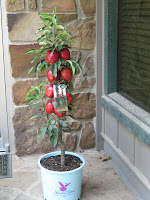Today, Friday, February 18, 2011 begins the Great Backyard Bird Count which runs through Feb. 21. Although it is called “Backyard” participants are encouraged to count in parks, woods, farms, and campuses for minimum intervals of 15-minutes. Then post the count on the website, sponsored by Cornell and Audubon. This Video explains in detail just how to participate.
Since it is easy to count birds while they are distracted by feeding, consider planting berried shrubs to attract birds to the garden. An adaptable broadleaf evergreen shrub perfect as a specimen plant or grown as a narrow, dense hedge, Christmas Jewel® Holly PP14477 is a beautiful Ilex pernyi hybrid hardy in USDA Zones 6-9. Fifteen year old plants are 9' tall by 6' wide with an upright, dense pyramidal shape achieved naturally without pruning. Polished dark green leaves of Christmas Jewel® are small, narrow and long with blunt spines that are not very sharp to the touch. Christmas Jewel® Holly is a lovely, low maintenance addition to the landscape.
Christmas Jewel® Holly plants are female, producing abundant, large, apple-red berries without the need of a pollinator. The berries turn red before Christmas and last until early summer or until they are eaten by wild birds. Typically, birds won’t eat Ilex berries until late in the winter season when they have been softened by alternate freezes and thaws.
According to docstoc, holly berries have among the highest nutritive value for [British] berries with a value of 4.75, and these highly nutritious berries that are available at the right time of year.
Bird species that eat holly berries include flickers, mocking birds, thrashers, flickers, catbirds, waxwings, cardinals, blue jays, as well as mourning doves, ruffed grouse, bobwhite and wild turkeys. Deer, voles, squirrels, chipmunks, rabbits, hares and even bears, red foxes, raccoons and box turtles all eat holly fruit.
Some birds like robins normally eat insects and worms, but become fruit-eating birds or frugivores in late winter, and the nutritious red holly berries are available to them.
By planting Christmas Jewel® Holly or other berried shrubs in the landscape, your bird species counts may be enhanced for the Great Backyard Bird Count.
Photo credits: Garden Debut(R) and bird photos courtesy StateSymbolUSA.org

















 Hope you'll be trying these this spring!
Hope you'll be trying these this spring! 




